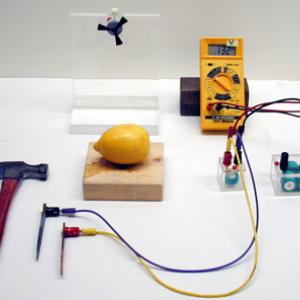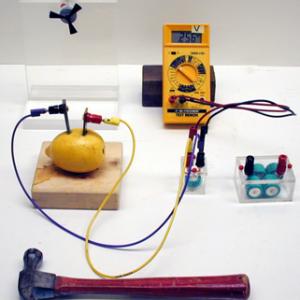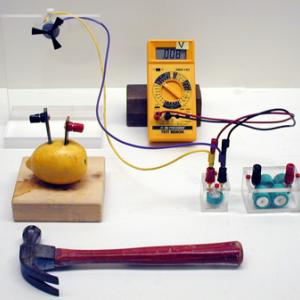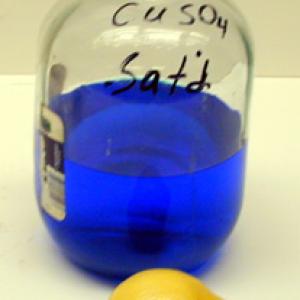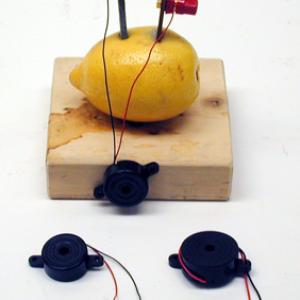College of Liberal Arts & Sciences
5E40.25 - Lemon Battery
Put the lemon on the board and drive in the electrodes so that they are approximately 1 inch apart. Plug the leads from the voltmeter into the electrodes and observe the voltage. Now plug the motor into the electrodes and observe that nothing will happen as the lemon does not generate enough current to run the motor. Now unplug the leads that run to the motor and plug them into one of the capacitor modules. After the appropriate amount of time, as observed when the voltmeter reaches its highest value, unplug the leads that are connected to the electrodes in the lemon and plug them into the motor. The motor will now run for up to 1 minute on the stored charge.
NOTE: The single 1 farad capacitor takes at least 20 minutes to charge and will run the motor about 50 seconds, whereas the 4 capacitors in series (250,000 microfarads) takes less than 10 minutes to charge but will run the motor for only 15 seconds. CHOOSE THE ONE APPROPRIATE FOR YOUR SITUATION.
NOTE: For best operation of the lemon roll it on a table while pressing on it to break up some of the tissue cells on the inside.
A fresh lemon will give a voltage reading of about .89 volts when used in this manner. With time (approximately 24 hours) this voltage reading will rise to about 0.98 volts. This is due mainly to the dissolution of some of the electrode material into the lemon tissue, as observed by the blue and black areas that develop around the electrodes. The higher the voltage, the better this demonstration work so it is advantageous to get the higher voltage without the waiting period. To do this inject 2cc. of saturated Copper Sulfate solution into the middle of the lemon. This step simulates the dissolution of the copper electrode into the lemon tissue. Again roll the lemon to disperse the copper sulfate throughout the lemon tissue. Now the fresh lemon will develop the 0.98 volts without the waiting period. Using a copper and Mg electrode will give approximately 1.5 to 1.6 volts for the lemon battery and therefore reduce the charging time.
While you can not usually run motors and lights directly off of the lemon, a low-voltage low-current Piezo buzzer works quite nicely.
- Courtney W. Willis and Lois Nicholson, "The Lemon Screamer, the Lasagna Cell, and the Physics Teacher", TPT, Vol. 28, #5, May 1990, p. 329.
- Jim Szeszol, "Doing Physics", TPT, Vol. 26, #1, Jan. 1988, p. 60.
- Theodore Gray, "Apple Juice", Popular Science, Vol. 281, #4, Apr. 2009, p. 74.
- "E-360. Lemon and Human Batteries", DICK and RAE Physics Demo Notebook, 1993.
- "E-320. Lemon Battery", DICK and RAE Physics Demo Notebook, 1993.
- Tik Liem, "Electricity From a Lemon", Investigation to Science Inquiry, p. 283.
- "Lemon-lit and Potato-Powered LED", National Geographic Kids, p. 19.
- Don Rathjen and Paul Doherty, "Saltwater Pentacell", Square Wheels, 2002, p. 85.
- Jearl Walker, "5.27. Lemon Battery, Tingling of Teeth Fillings", The Flying Circus of Physics Ed. 2, p. 231.
- Mark Frauenfelder, "Fruity Power Plant", Mad Professor - Concoct Extremely Weird Science Projects, ISBN 0-8118-3554-5, p. 70.
- Terry Cash, Steve Parker, and Barbara Taylor, "Chemical Electricity", 175 More Science Experiments to Amuse and Amaze Your Friends, p. 116.
- Robert Ehrlich, "L.2. Lemon Battery", Turning the World Inside Out and 174 Other Simple Physics Demonstrations, p. 146 - 147.
- Joey Green, "Electric Lemon", The Mad Scientist Handbook, Vol. 1, p. 21.
- Carl Ahlers, "Drawing Electricity From a Pencil Sharpener", Expose Excite Ignite An Essential To Whizz-Bang Chemistry.
- Brian Carusella, "Electricity from a Lemon", Bizzar Labs, © 1997, http://bizarrelabs.com/lemon.htm.
- Daniel J. Swartling and Charlotte Morgan, "Lemon Cells Revisited - The Lemon-Powered Calculator", Journal of Chemical Education, Vol. 75, #2, Feb 1998, p. 181.
- Rudolf F. Graf, "Getting Electricity from a Lemon", Safe and Simple Electrical Experiments, p. 78.
- Borislaw Bilash II, “A Lemon of a Battery“, A Demo A Day – A Year of Physical Science Demonstrations, p. 281.
- The Queen Catalogues Vol. II, Catalogue of Physical Instruments, No. 5460, p. 94.
Disclaimer: These demonstrations are provided only for illustrative use by persons affiliated with The University of Iowa and only under the direction of a trained instructor or physicist. The University of Iowa is not responsible for demonstrations performed by those using their own equipment or who choose to use this reference material for their own purpose. The demonstrations included here are within the public domain and can be found in materials contained in libraries, bookstores, and through electronic sources. Performing all or any portion of any of these demonstrations, with or without revisions not depicted here entails inherent risks. These risks include, without limitation, bodily injury (and possibly death), including risks to health that may be temporary or permanent and that may exacerbate a pre-existing medical condition; and property loss or damage. Anyone performing any part of these demonstrations, even with revisions, knowingly and voluntarily assumes all risks associated with them.
